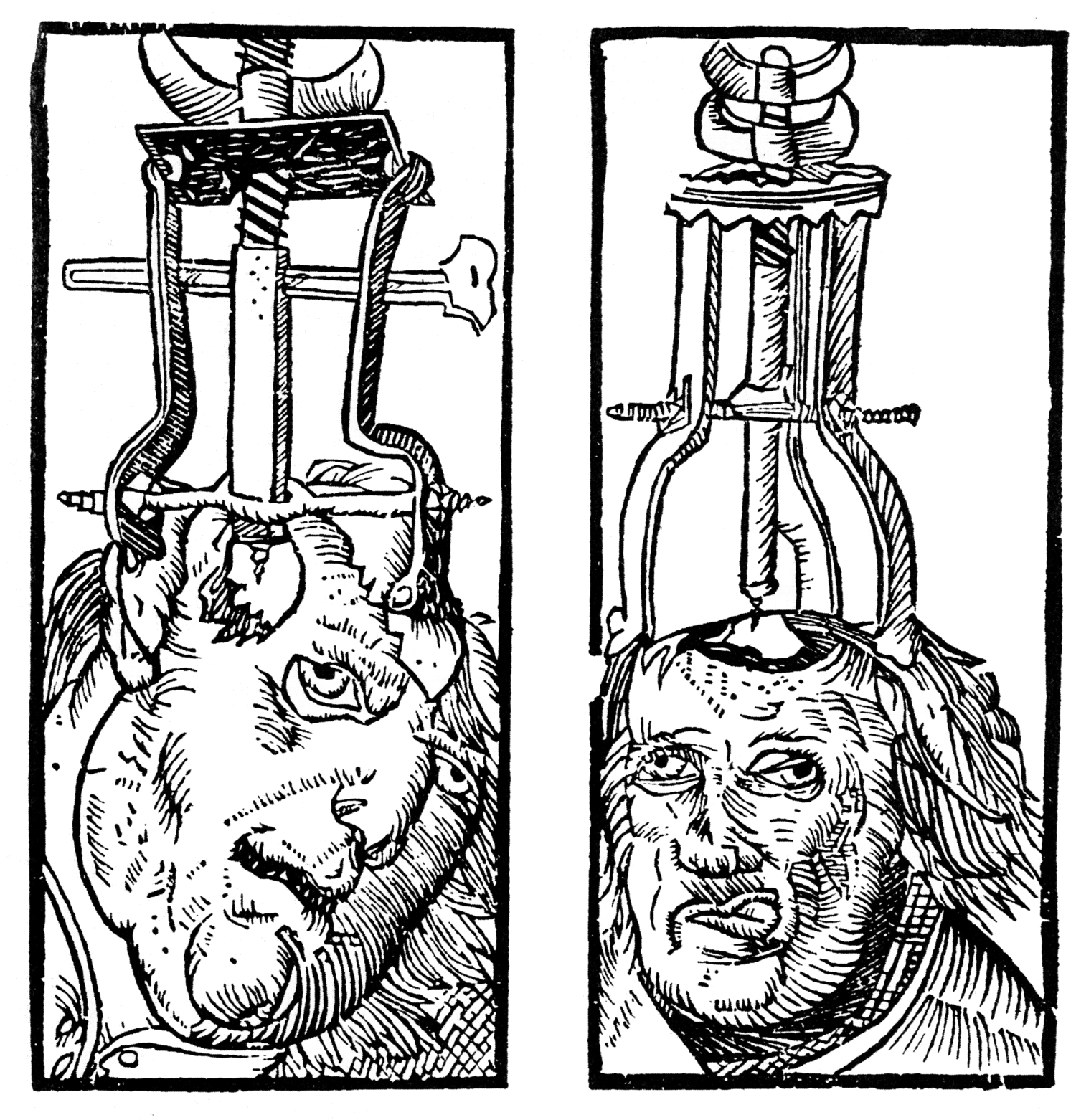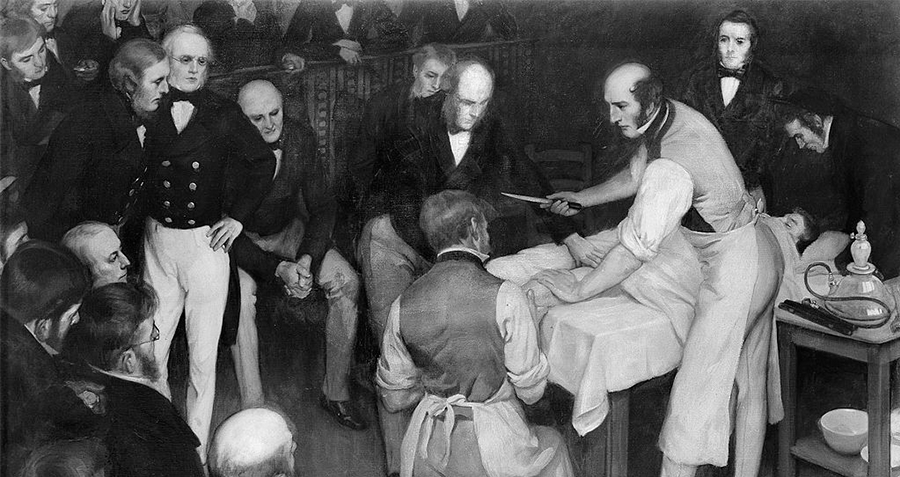

At some point in our lives, most of us will go under a surgeon’s knife. It seems so commonplace now, but until recently, it was exceedingly rare, dangerous, excruciating, and only done when things like prayer, magical poop poultices, or massive doses of opium didn’t do the trick. Let’s now have a gander at some of the oddball standouts of surgical history. The list is far, far longer than this wispy overview can possibly cover, so we’re just scratching the surface here—but let’s scratch at it with an unsterilized scalpel, shall we?
Also called Trepanning, or sometimes "are you fucking kidding me?", trepanation was (and is, in some circles) a surgical intervention performed since at least 6500 BCE, and possibly much longer. Archeological evidence backs this up, and it appears to have been a widespread treatment for... (insert shrug here) all kinds of stuff since that time. Basically, trepanation is the drilling of a hole into your skull, exposing your brain to the air. This practice wasn’t limited to one geographical area or culture and was seen in Mesoamerica, Medieval East Africa, Europe, Siberia, and even ancient China. It’s still practiced today (though it falls deeply into the pseudoscientific fringe of people who fuck themselves with crystal dildos to recharge their Chi and the like). It’s been claimed as a treatment for demon possession, depression, seizures, headache (?!), mental disorders, and not having a hole in your head, among other things. It’s also been used for spiritual purposes, like having your life flash before your eyes as someone airs out your brain with a drill. On a side note, a cow skull dating back to 3400-3000 BCE was found in France that had been trepanned, and I really wish I knew the story behind that. Was it a practice run, or did the cow have a headache? I don’t suppose I’ll ever know, but that won’t stop me from wondering.

Figure 1: Trepanation for fun and profit
In the 1840s, surgeon Robert Liston was renowned for his breakneck speed amputations. Since suitable sedation was not available, speed was the only way to make such a harrowing event doable. Once, he removed a 45 lb scrotal tumor that the owner had to take around in a wheelbarrow in just 4 minutes! Another time, he amputated a leg in just 45 seconds, though in his haste, he also removed his patient’s testicles—as a bonus. His most well-known case was, perhaps, a leg amputation he performed in under two and a half minutes. On this occasion, however, the patient later died from gangrene, as they so often did at the time. He also amputated the fingers of his assistant in his haste, who also succumbed to gangrene, and in what I imagine was a dramatic flourish, slashed the coattails of a spectator, who then fainted and later died of shock, effectively giving Liston the dubious honor of performing the only surgery on record with a 300% mortality rate.

Figure 2: Stand back; I’m about to set a record!
During the Middle Ages, in Europe, before any modern medical standards were required, there was the "Barber Surgeon." Of all the professions to trust with one’s health, a barber seems like an odd choice. Not utterly without merit, though—a man with a razor and a deft hand for beard sculpting isn’t ideal, but I suppose if you’ve nowhere else to turn, then there’s not really much of a choice. The mortality rate from visiting your local barber-surgeon was often astronomically high, so one really only went if there was no other option. They could pull teeth, do your bloodletting, perform amputations, make ointments, and diagnose various ailments. Over time, this strange professional pairing would taper off in popularity, but for a while there, you could get a haircut and a tooth extraction at the same place. One-stop shopping!
In what seems like a bit of an oversight, António Egas Moniz still shares the 1949 Nobel Prize for Physiology or Medicine for discovering the "therapeutic value of leucotomy in certain psychoses." If by therapeutic value, they mean whisking someone’s brain into a slurry, well—sure, I suppose being a drooling, incontinent vegetable is probably easier for some people to deal with than psychosis. One of a number of treatments falling under the absolutely delightful umbrella of "therapeutic nihilism" (ECT, more commonly known as shock treatment, its official title is "electroconvulsive therapy," insulin shock therapy, that’s just putting you into an insulin coma, deep sleep therapy—which sounds nice, but was a drug-induced snooze for days or weeks and led to the death of several patients, etc.) The leucotomy was first discovered in Europe in the 1930s and went on to be used extensively through the 1950s, when people realized that maybe sticking an icepick in your eye and wiggling it around in your frontal lobe might be an imprecise practice. The rise and popularization of first the leucotomy (marginally more scientific, but that’s not saying much), then later the more well-known "icepick lobotomy," by Dr. Walter Freeman, led to countless people who were looking for a way to treat their own or loved one’s ailments to be profoundly disappointed. Like buying sea monkeys or Ikea furniture, it sounded like a sure thing but was just a huge bummer. Often, recipients of this procedure would be emotionally blunted, suffer a loss of self-awareness, responsiveness, cognition, initiative, and so on. By 1951, almost 20,000 lobotomies had been performed in the US—the great majority on women. Famous cases include Rosemary Kennedy (who was institutionalized and helpless for the rest of her life) and Tennessee Williams’ older sister (also incapacitated for the rest of her life). Arguably, Phineas Gage* falls into this category, but that wasn’t so much a surgery as a "whoopsy."

Figure 3: Is it just me, or does this person look positively bored?
Phineas Gage (1823-1860) was an American railroad worker who miraculously survived a terrible accident in which a large tamping iron was driven directly through his skull. His personality was said to have changed dramatically, and he went from having a pleasant, genial demeanor to basically being an intolerable prick. This is thought to have been due to the brain damage he suffered from being skull fucked by a metal rod.
Popular as a cure and treatment for pretty much anything, bloodletting has been around since Ancient Egypt, at least. Some historians have posited that the Egyptians may have based their theories about the therapeutic value of bloodletting from observing hippopotamuses—whose red secretions may have been mistaken as blood, and the hippo’s habit of scratching itself could have been mistaken as an intentional cutting open of its own skin. If this is the case, the hippo’s already impressively deadly potential is far more insidious than we knew. Bloodletting has been performed with leeches, knives, the super menacingly named "Scarifcator..." We’ve collectively been vampirizing ourselves for thousands of years, and thousands of reasons, though it has little to no actual medical value. While not actually a full-blown "surgery," I’d be remiss in not mentioning what might be the silliest invasive medical procedure ever.

Figure 4: The Scarificator, in all its sinister glory
While by no means an exhaustive or complete list of the absolute craziness that constitutes the history of surgical practice, I hope you can come away today with at least one weird, new fact to horrify your friends with.
Esmeralda Rupp-Spangle is an amateur surgeon and aspiring butcher. She can be tracked down on Facebook as Esmeralda Marina and Instagram as @EsmeraldaSilentCitadel.